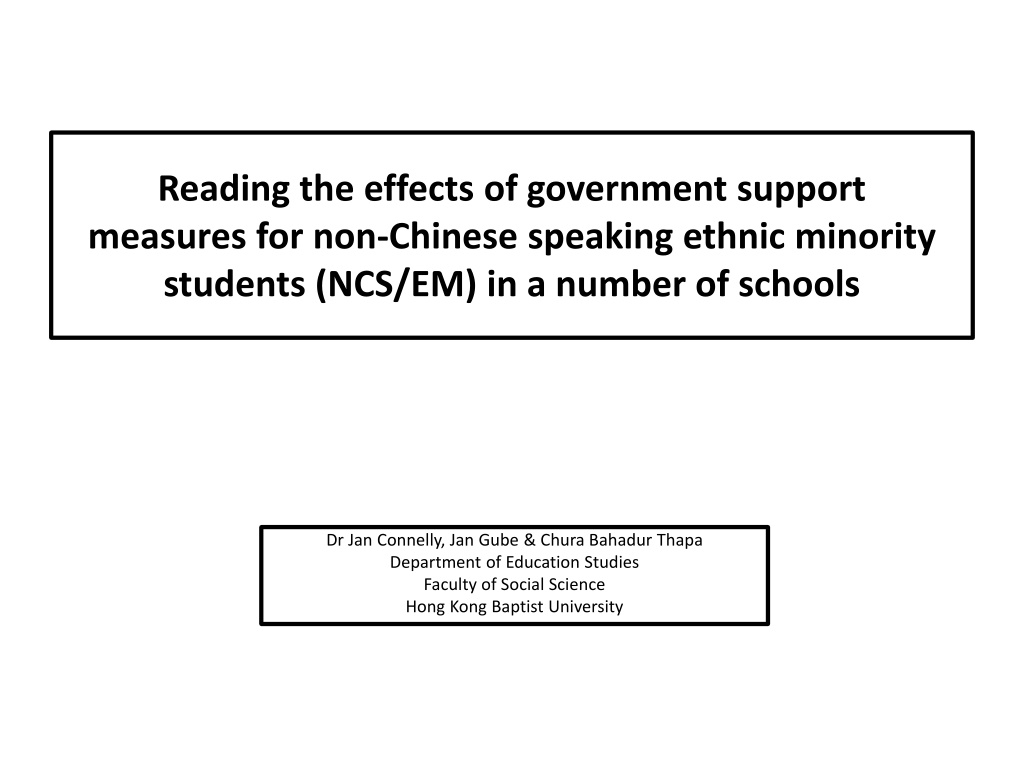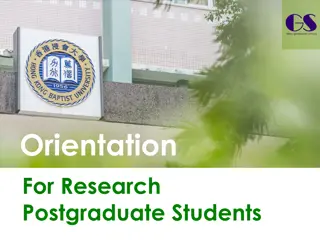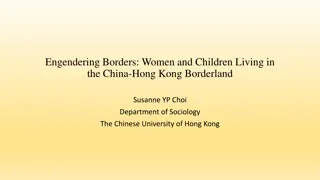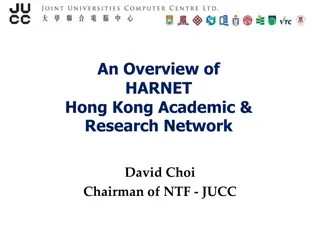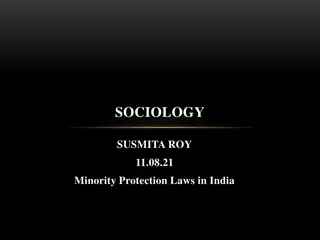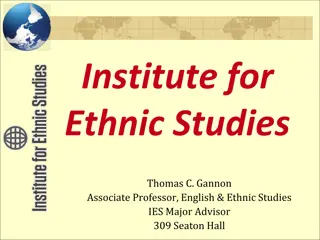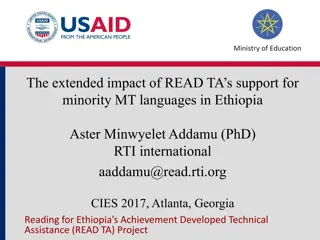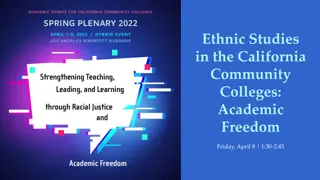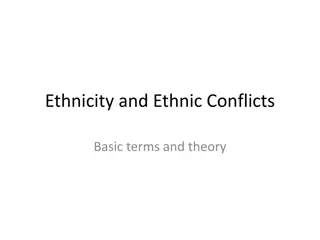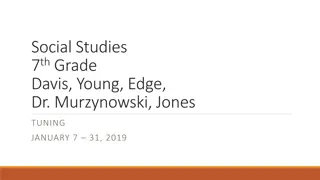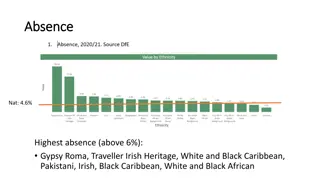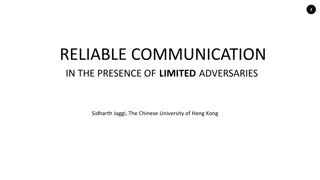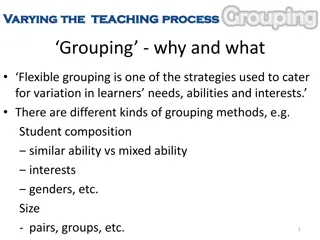Integrating Ethnic Minority Students in Hong Kong Schools: Government Support Measures Study
Exploring the impact of government support measures on non-Chinese speaking ethnic minority (NCS/EM) students in Hong Kong schools, a research project by the Faculty of Social Sciences at Hong Kong Baptist University analyzed policies aimed at addressing language and cultural barriers, promoting integration, and enhancing educational opportunities for these students. The study identified the backgrounds of EM/NCS students, assessed the current schooling situation, and presented findings to suggest a way forward for improved support strategies.
Download Presentation

Please find below an Image/Link to download the presentation.
The content on the website is provided AS IS for your information and personal use only. It may not be sold, licensed, or shared on other websites without obtaining consent from the author. Download presentation by click this link. If you encounter any issues during the download, it is possible that the publisher has removed the file from their server.
E N D
Presentation Transcript
Reading the effects of government support measures for non-Chinese speaking ethnic minority students (NCS/EM) in a number of schools Dr Jan Connelly, Jan Gube & Chura Bahadur Thapa Department of Education Studies Faculty of Social Science Hong Kong Baptist University
Presentation Overview Who are EM / NCS students? Background EM/NCS students schooling in Hong Kong The Research Findings Way forward
The Faculty of Social Sciences at Hong Kong Baptist University funded a research project into government support policies and practices in schools for Ethnic Minority and Non-Chinese Speaking students henceforth (EM/NCS) (2011-2012) Using responsive evaluation the government support measure policies were tracked to determine whether they were achieving their stated aims of: (i) alleviating the obstacles of language and cultural barriers, (ii) facilitating smoother integration of EM/NCS students into Hong Kong society, and (iii) positively impacting the educational opportunities of EM/NCS students
Who are the Ethnic Minority (EM) and Non-Chinese Speaking (NCS) students? EM/NCS students are: students who come from(but not exclusively) cultural and linguistic backgrounds of Hong Kong s neighbouring South Asian countries such as India, Pakistan, Nepal, the Philippines, Indonesian and Thailand. These students families might be 2nd/3rd generation permanent residents, or newly arrived. They are referred to as EM students. students who have multi-ethnic parentage and present at school with linguistic competencies (and some schooling) in language variations other than Chinese.
How many EM/NCS students are in HK schools? According to EDB s Statistics No. of NCS students No. of schools accepting NCS students 2006/07 2012/13 2006/07 2012/13 260 142% out of 537 (10 Designated Schools) 322 56% Out of 557 (21 Designated Schools) Secondary 2600 6900 165% 107 Primary 4500 7900 75% 206
Background to the education of EM/NCS students in Hong Kong local Schools Government policy over the last ten years has attempt to respond to the educational needs of EM and Non-Chinese Speaking (NCS) students in Hong Kong government schools. Through broad-ranging support measures, funding to designated schools, supplementary guides for teaching Chinese, teacher support (mentoring Primary schools & HKU Chinese Lang. Support Centre for Secondary schools) all with the primary focus of increasing EM/NCS students Chinese language proficiency. What tangible progress has been made? it still appears that few ethnic minority students complete their final years of schooling Less than 50% had met the minimum requirements to be admitted into Senior Secondary in 2008/2009 with only 24 NCS/EM students taking Senior Secondary final-year examinations (LegCo, 2009).
The Research Explored students and their teachers responses to the current education support measure policies for EM/NCS students across 6 schools. It attempted to examine the challenges that principals and teachers face in meeting the complex educational needs of a multicultural and multi- lingual student body trying to succeed inside an educational jurisdiction that expects a high level of competency in written Chinese in order to access higher education opportunities. The contexts of these schools could be substantially different from other designated and non designated schools elsewhere
Data Sample 1: School A : School has 396 students 233 (95%) areEM/NCS students from South Asian heritage and English was not their first language. Student responses -languages spoken:
Data Sample 2: School B : School has 218 students 31% are EM/NCS students. Majority are mixed heritage students; [UK/Chinese, US/Filipino, Chinese/Swiss, Canadian/Chinese, Thai/Chinese]English is the students language of communication at school. They speak these languages:
Teacher Responses: School A Teacher Responses: School B
Findings indicate, teachers (particular newer ones) may not have a marked understanding of their students cultures and no professional development that could raise awareness of the social and cultural identity struggles students encounter in the interface between home culture and the dominant Chinese culture of Hong Kong schools. Big difference [between EM/NCS & Local students]. EM/NCS students are weaker in Maths. They perform poorly. There are many factors. First, their family background. Maybe no one helps them. Parents expectation on (children s) education is low. The students always don t come to school and parents seldom tell them to do homework In Maths you always have to do homework and exercises. They re lazy. And their families always have to go to temple, for adoration. The parents told us [they] don t have time for homework.[Class teacher] .the most problematic [issue] is discipline. Because they re so different from Chinese, they don t have that many rules. [They re] free at home. Specially Indians and Pakistanis. Even P.1, when they go downstairs at recess, they punch people They said their parents taught them that You also have to teach them to love and care for one another, moral stuff like that. [Class Teacher] our school has not yet organized any workshop or training for teachers to teach EM/NCS students. It s just like putting you inside the classroom, if can manage to teach then teach. you just have to learn from your mistakes. [Class Teacher]
Findings indicating teachers needs . ... what we need most is a [centralised primary] curriculum, especially Chinese curriculum. Because EDB s hasn t adapted the curriculum the curriculum they provide us is only a modified version of the mainstream one. So it s not [a curriculum] for our non-Chinese students. if you want the curriculum to be successful, (tailor lessons) for example for non-Chinese students, the curriculum s aim and key learning areas shouldn t be compared with mainstream students. [Class teacher] In terms of support from the EDB a teacher visits and prepares lessons with us (One of the) three main points for P5 is speaking-led writing. Aside from the design of worksheet, we design and receive her comment on our work, she talks about the activity details in classes. After learning those we apply them in our lessons. It s like that. But in practice whether you use them or not it s another matter. But she shares her experience with us and doesn t force us. She tells us what other schools have done it. . A lot of teachers try and follow it. It really impacts our lessons compared to in the past when we didn t have such support. [Class teacher] we don t have enough [resources] when EM/NCS learn Chinese, [it involves] resources, our existing Chinese [language learning] resources are insufficient we use school-based curriculum [but] it s like we re at the end of our rope, it keeps us dangling honestly speaking. So that s not an effective way to do things. [Class teacher] EDB still prefer [we use] a school-based curriculum. Because different districts are made up of different NCS students from different origins. Some have no background in Chinese at all. among the EM/ NCS there are those from abroad, those born locally, their [backgrounds] are varied diversity in Hong Kong has existed long ago not just NCS has difference, the locals themselves have diversity too. So if EDB gives this as an excuse that why there is no centralised Chinese curriculum in primary school, it s unwise because of the great diversity, EDB should push through its launch. Because when they launch this [centralised] curriculum, we can adapt it A teacher s role is that we have a set of things to work from and we teach based on [students ] abilities [with it] at least we have a backbone; a foundation; without it, how can I [teach]? [Class teacher]
Findings indicate dissatisfaction with policies Concerns about the Designated School policy (noted in literature and reinforced in this research) were that within a few years of a school enrolling Ethnic Minority immigrant students, the number of Chinese students at the school begin to decline. This flight by Chinese students results in schools quickly becoming an NCS/EM school entirely.All but one schools in this research were originally facing declining student enrolments (of local Chinese students). The decision to enrol Ethnic Minority /Immigrant students was a way to save the school from the threat of closure. Chinese students were dropping (in numbers). So the EDB asked whether we want to admit these (NCS) students. If you admit them then the EDB give you funding. We survived through it [but] we ve lost the local students.[Class teacher] Schools that enrol NCS/EM students and who do not receive funding sometimes prefer to remain non- designated (they fear the designated school label will result in Chinese parents being discouraged from enrolling their children in the school) (Principal of Designated School) Whilst the government claims the policy support measures will alleviate cultural barriers and facilitate smooth integration of NCS/EM students, the inquiry s findings reveal little evidence of this. Only one school out of the 6 attempted to address cultural barriers by employing Ethnic Minority Teaching Assistants, conducting home visits and encouraging interaction between parents, students and staff. There was some evidence from schools participating in this inquiry that acknowledged the need for the professional awareness support that would engage local Chinese teachers in reflection and discussion to deepen their understanding about how to best teach in multicultural and multilingual contexts.
Answers to research question do support measures .. alleviate the obstacles of language barriers? Yes the support measures are welcomed but 92% of teachers said more support is needed with Chinese curriculum adaptations, resources, and professional development alleviate the obstacles of cultural barriers? No the focus of support is on Chinese language acquisition not on cultural awareness, respect and understanding only one school attempted to address cultural barriers by employing Ethnic Minority Teaching Assistants, making school visits, encouraging cultural interaction.
Do support measures .. facilitate smoother integration of NCS/EM students into Hong Kong society? No Designated school structures create further divisions between schools resulting in separatist education and negative labelling No Inside some designated schools EM/NCS students are separated from local Chinese students further limiting opportunities for mutual respect and multicultural awareness
Do support measures .. positively impact the educational opportunities of NCS/EM students Yes but only if schools redefine the support (e.g. School A s employment of EM/NCS Teaching Assistants) & build communication links between schools and EM/NCS families. No despite the support in schools EM/NCS students are not reaching local students level of Chinese proficiency policies such as the core subjects for Uni. entrance (Chinese & English) lock out EM students; if they fail one subject they have no chance of enrolling.
Way forward what else can be done? Research and inquiry is needed into Policies and Pedagogical Practices Systematic monitoring, and analysis of data on EM/NCS students learning outcomes, and independent evaluation of support programmes so as to inform policy support measures; Development of a coherent Chinese-Second-Language curriculum and a new Senior Secondary Chinese subject for tertiary entry that addresses the needs of EM/NCS students; Professional Development that increases teachers; (i) competency in Chinese-as-Second-Language (CSL) and (ii)ability to teach effectively inside culturally and linguistic diverse contexts; Incorporation of elements into Hong Kong schools that draw on the cultural background of EM/NCS students (see Moll et. al., 2001 - Funds of Knowledge) Dismantle designated schools and practices of segregation linking funding to EM/NCS students and their needs;
